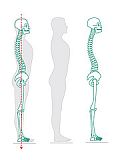Improving Your Posture With Pilates

The body must be re-educated to cope with the stresses of daily life. In cases where the postural fault is severe, or there is pain, you should see a specialist before attempting this or any other exercise programme. Pilates is not meant to be an alternative to the prescription of a medical professional, but it can be a useful too to accompany the recommendations of a specialist. When people train in the gym they tend to choose exercises randomly, concentrating on the areas of the body they like the least, or doing exercises that they find easy to do, this can reinforce existing misalignments. Unless the body is trained as a whole, as in Pilates, its weaknesses will only be reinforced. The regular practice of Pilates strengthens and stretches all the core postural muscles, making correct posture far less of a muscular effort and more of an unconscious act.
To understand the whole picture it is essential to realize the importance of the torso. Every step you take, every weight you lift and every movement you make must be stabilized by the muscles of the abdominals and the back to protect the spinal cord against injuries. It does not matter how strong your arms are, unless your torso can protect you by stabilizing internally, your strength will be limited. Think of your body as a chain of muscles, you are only as strong as your weakest link. If your posture is not good, your muscles will have been working in an incorrect manner for a long time. You cannot force them into place in a few sessions, there will be a period of adaptation. Always seek medical advice if you feel pain either during or after exercise. However, it is good to learn to differentiate between sore muscles and pain. Muscle soreness is part for the course when you begin to exercise, you will feel it most about 48 hours later. Stretching out the muscles at the end of a session helps, as can a hot bath. You may also want to try some of the wide variety of gels and creams designed to ease muscular tension. Ask your pharmacist for a recommendation.
Good Posture Check:
Take up your stance in front of the mirror again. Only this time adopt what you consider to be “good posture”. You should note the following points. Can you see them in your reflection?
- Shoulders are level.
- Hip bones are equal and symmetrical.
- The thumb side of the hand faces forward.
- The knee joints are symmetrical and face forwards.
- The ankle joints symmetrical.
- The weight of the body is equally distributed between all four :corners” of the feet.
- You are lengthening through your spine.
Tips:
- When you are standing correctly, the knee and ankle joints are symmetrical and the knees face forwards.
- Pilates works by strengthening the key postural muscles, making it physically more comfortable to maintain the correct alignment.
- The weight of the body should be equally spread between all four “corners” of the feet. Weakened muscles or rapid weight gain may have led the arches in the feet to collapse.
- Stand in front of the mirror and carefully check your posture. Pay special attention to your hips, arms, shoulders, spine and weight distribution.
- Become aware of how people respond more positively to you as your posture changes.